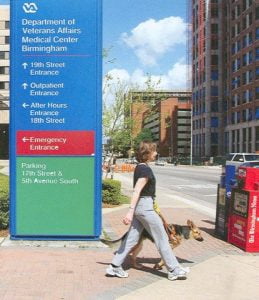[box]Originally posted on September 6, 2012 on the OHI Grapevine, the blog of the Veterans Health Administration’s (VHA) Office of Health Information (OHI).[/box]
At 26 years of age, my life had hit rock bottom. Deeply depressed, I had reached the point where I believed I no longer had options. Placing a loaded gun to my head, I pulled the trigger. There was an explosion and, in an instant, my world went dark.
I didn’t die, but the failed attempt left me blind. I was still depressed, but now I would have to deal with blindness on top of the depression.
I entered into an intensive program of blind rehabilitation during which I learned new ways of doing almost everything. The process of rehab gave me the confidence  to take the first steps forward. As success built on success, I began to rebuild my life. I immersed myself in my rehab program, learning everything from Braille to using a long cane to travel. After completing my formal rehabilitation, I entered the field of blind rehab, obtaining a Master’s degree from Western Michigan University a few years later. I worked in the field for more than 20 years, the last five of which I spent at the VA Southeastern Blind Rehabilitation Center in Birmingham, AL as the subject matter expert for the computer access training section. In 2007, I left the rehab field to take my current position as a VHA Section 508 analyst.
to take the first steps forward. As success built on success, I began to rebuild my life. I immersed myself in my rehab program, learning everything from Braille to using a long cane to travel. After completing my formal rehabilitation, I entered the field of blind rehab, obtaining a Master’s degree from Western Michigan University a few years later. I worked in the field for more than 20 years, the last five of which I spent at the VA Southeastern Blind Rehabilitation Center in Birmingham, AL as the subject matter expert for the computer access training section. In 2007, I left the rehab field to take my current position as a VHA Section 508 analyst.
I’ve reached a point in my life where I feel I can help others by telling my story. I’ve written a book about my journey scheduled to be published in spring 2013. Going public with my story is a decision that I will never regret. I have started speaking publicly about what I went through and the reaction has been overwhelmingly positive. Again and again people tell me that they have considered suicide, attempted suicide, or know someone who is considering suicide.
Over the years I’ve talked at least three people back from the edge of trying to end their lives. I want to offer what I gave those people to anyone who thinks that life is not worth living. There is always hope.
According to the American Association of Suicidology (AAS), approximately 922,725 Americans attempt suicide each year and nearly five million Americans have a friend, family member, or loved one who has committed suicide. The numbers are staggering.
With the start of National Suicide Prevention Week on Sunday, September 9, VA is working with community-based organizations, Veterans Service Organizations (VSOs), health care providers, private companies and other government agencies to increase awareness of suicide warning signs and risks. VA also is leading an effort to encourage individuals to show their support for Veterans by signing an online pledge at www.VeteransCrisisLine.net to learn the signs of a crisis.
The Veterans Crisis Line, online chat and text messaging services offer free, confidential support 24 hours a day, 7 days a week to Veterans and their families and friends. Veterans or anyone concerned about a Veteran may call 1-800-273-8255 and Press 1, chat online at www.VeteransCrisisLine.net or text 838255 to receive support.
Since its launch in 2007, the Veterans Crisis Line has answered more than 650,000 calls and made more than 23,000 life-saving rescues. In 2009, the Veterans Crisis Line added the anonymous chat service, which has helped more than 65,000 people. More information is available at www.VeteransCrisisLine.net and www.mentalhealth.va.gov.
Today I’m blissfully married to Jim, my husband of 27 years. My work with the VHA Section 508 team is fast-paced and exciting. Instead of the dread with which I faced each new day all those years ago, I now greet each new day in eager anticipation of what I’ll discover.
I am proud of what I’ve made of my life. I’m also extremely grateful to the people who have helped me along the way. I didn’t do it in a vacuum. The important thing, if you feel your life is not worth living, is to talk about it and get help. For more information about my experiences, you can visit the following site: www.OutOfTheWhirlpool.com.
 Sue W. Martin is a Management Analyst with the VHA Section 508 Office where she manages the accessible e-learning project. She has continued teaching assistive technology and recently donated two training packages to a fundraising effort for The Seeing Eye, Inc. Sue lives in Springville, AL and likes taking long walks with her Seeing Eye Dog, Kismet.
Sue W. Martin is a Management Analyst with the VHA Section 508 Office where she manages the accessible e-learning project. She has continued teaching assistive technology and recently donated two training packages to a fundraising effort for The Seeing Eye, Inc. Sue lives in Springville, AL and likes taking long walks with her Seeing Eye Dog, Kismet.
Note: In July 2012, Freedom Scientific, the largest worldwide manufacturer of assistive technology products for those who are blind or have low vision interviewed Sue for their official podcast series. It’s the first public interview she has given concerning her life and her writing. To listen to the podcast, visit www.freedomscientific.com/FSCast/default.asp.

Pingback: Catching up « Safe & Sound blog
Pingback: Easter Seals Blog » Blog Archive » Talk about it, and ask for help!